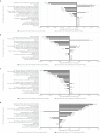Impact of neurofibromatosis type 1 with plexiform neurofibromas on the health-related quality of life and work productivity of adult patients and caregivers in the UK: a cross-sectional survey
- PMID: 37996843
- PMCID: PMC10666383
- DOI: 10.1186/s12883-023-03429-7
Impact of neurofibromatosis type 1 with plexiform neurofibromas on the health-related quality of life and work productivity of adult patients and caregivers in the UK: a cross-sectional survey
Abstract
Background: Plexiform neurofibromas (PN) are complex, benign nerve-sheath tumours that occur in 30-50% of patients with neurofibromatosis type 1 (NF1), a rare, genetic disorder. PN are associated with substantial, heterogeneous morbidities that impact health-related quality of life (HRQoL), including affecting motor function and causing pain, though HRQoL and work productivity data are scarce. This UK cross-sectional study explored HRQoL and work productivity in adult patients with NF1 PN and caregivers of paediatric patients.
Methods: Adult patients and caregivers of paediatric patients self-enrolled in an online survey (March-April 2021). Outcomes included EQ-5D-5L, PROMIS® GH and INF1-QOL (adult patients only), and EQ-5D-5L, CarerQol and WPAI (caregivers only). Utilities were estimated from EQ-5D-5L responses using the UK crosswalk value set. Linear regression models explored univariable associations between adult patient characteristics and HRQoL.
Results: Mean (± standard deviation) EQ-5D utility in adult patients with NF1 PN was 0.65 (± 0.29; n = 35; age-/sex-matched norm: 0.89 [± 0.04]). Moderate-extreme pain/discomfort and anxiety/depression were reported by 14/35 (40.0%) and 18/35 (51.4%) patients, respectively. Mean PROMIS® GH physical and mental health scores were 43.6 (± 9.19) and 41.7 (± 11.5; n = 35; matched norm: 50.0 [± 10.0]). Mean INF1-QOL score was 11.03 (± 6.02; n = 33). Chronic itching, at least one symptom, at least one comorbidity, PN location at extremities (arms/legs) and pain were associated with worse HRQoL scores. Mean caregiver EQ-5D utility was 0.72 (± 0.24; n = 8; age-/sex-matched norm: 0.88 [± 0.03]). Moderate pain/discomfort and moderate-severe anxiety/depression were reported by 4/8 (50.0%) and 2/8 (25.0%) caregivers, respectively. Mean CarerQol score was 69.3 (± 13.9; n = 8). Mean WPAI regular activity productivity loss was 36.3% (± 31.6%; n = 8).
Conclusions: NF1 PN worsens adult patient and caregiver HRQoL compared to the general population, notably affecting pain and discomfort, anxiety and depression and caregiver productivity.
Keywords: Caregivers; EQ-5D; Neurofibromatosis; Plexiform neurofibromas; Quality of life; Utility.
© 2023. The Author(s).
Conflict of interest statement
HKY: Employee of Alexion, AstraZeneca Rare Disease; shareholder of AstraZeneca. VB: Employee and shareholder of AstraZeneca. AP, AN, KH, AG: Employees of Costello Medical. AL: Employee and stockholder of Acaster Lloyd Consulting Ltd. XY: Employee of MSD; stockholder in Merck & Co., Inc., Rahway, NJ, USA. GK: Ex-employee of AstraZeneca.
Figures

Similar articles
-
Long-term distress throughout one's life: health-related quality of life, economic and caregiver burden of patients with neurofibromatosis type 1 in China.Front Public Health. 2024 Aug 21;12:1398803. doi: 10.3389/fpubh.2024.1398803. eCollection 2024. Front Public Health. 2024. PMID: 39234078 Free PMC article.
-
Economic burden and quality of life of caregivers of patients with sickle cell disease in the United Kingdom and France: a cross-sectional study.J Patient Rep Outcomes. 2024 Sep 26;8(1):110. doi: 10.1186/s41687-024-00784-y. J Patient Rep Outcomes. 2024. PMID: 39325265 Free PMC article.
-
Burden Among Caregivers of Pediatric Patients with Neurofibromatosis Type 1 (NF1) and Plexiform Neurofibroma (PN) in the United States: A Cross-Sectional Study.Neurol Ther. 2022 Sep;11(3):1221-1233. doi: 10.1007/s40120-022-00365-5. Epub 2022 Jun 9. Neurol Ther. 2022. PMID: 35679001 Free PMC article.
-
Selumetinib for children with neurofibromatosis type 1 and plexiform neurofibromas that can't be removed by surgery, and impact on how the condition affects caregivers: a plain language summary.J Comp Eff Res. 2025 Mar;14(3):e240184. doi: 10.57264/cer-2024-0184. Epub 2025 Jan 21. J Comp Eff Res. 2025. PMID: 39835668 Free PMC article. Review.
-
Treatment decisions and the use of MEK inhibitors for children with neurofibromatosis type 1-related plexiform neurofibromas.BMC Cancer. 2023 Jun 16;23(1):553. doi: 10.1186/s12885-023-10996-y. BMC Cancer. 2023. PMID: 37328781 Free PMC article. Review.
Cited by
-
Multifocal Gastrointestinal Stromal Tumors (GISTs) of the Small Intestine in Patients with Neurofibromatosis Type 1 (NF-1): Meta-Analysis and Systematic Review of the Literature.Cancers (Basel). 2025 Jun 10;17(12):1934. doi: 10.3390/cancers17121934. Cancers (Basel). 2025. PMID: 40563584 Free PMC article. Review.
-
Discrimination of benign, atypical, and malignant peripheral nerve sheath tumours in neurofibromatosis type 1 - intraindividual comparison of positron emission computed tomography and diffusion-weighted magnetic resonance imaging.EJNMMI Res. 2024 Dec 27;14(1):127. doi: 10.1186/s13550-024-01189-0. EJNMMI Res. 2024. PMID: 39729173 Free PMC article.
-
Accounting for Biological Sex and Gender Identity in the Pathogenesis, Artistic Depictions, and Quality of Life in Neurofibromatosis Type 1.JID Innov. 2025 Jun 25;5(5):100393. doi: 10.1016/j.xjidi.2025.100393. eCollection 2025 Sep. JID Innov. 2025. PMID: 40741214 Free PMC article. Review.
-
The relationship between effort-reward imbalance and quality of working life among medical caregivers: mediating effects of job burnout.Front Psychol. 2024 Jul 25;15:1375022. doi: 10.3389/fpsyg.2024.1375022. eCollection 2024. Front Psychol. 2024. PMID: 39118848 Free PMC article.
-
Neurofibromatosis Type 1: Optimizing Management with a Multidisciplinary Approach.J Multidiscip Healthc. 2024 Apr 23;17:1803-1817. doi: 10.2147/JMDH.S362791. eCollection 2024. J Multidiscip Healthc. 2024. PMID: 38680880 Free PMC article. Review.
References
MeSH terms
Substances
LinkOut - more resources
Full Text Sources
Research Materials
Miscellaneous

